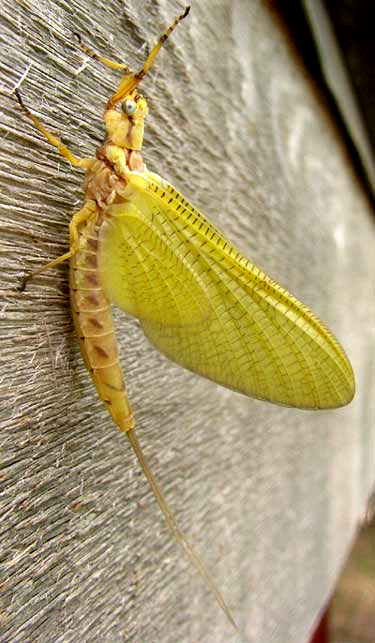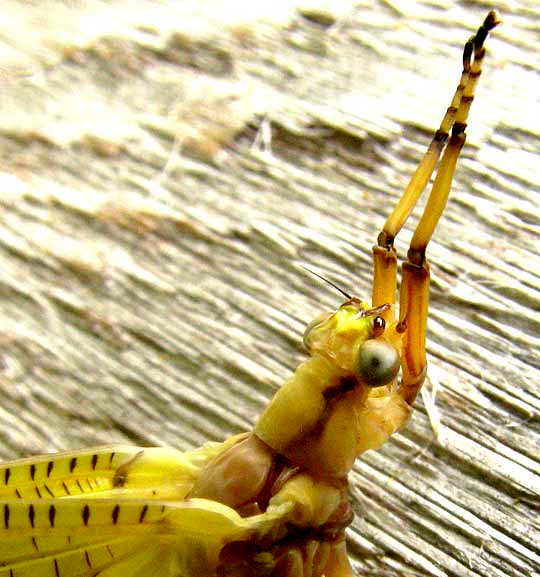Excerpts from Jim Conrad's
Naturalist Newsletter
from the May 18, 2014 Newsletter issued from the Frio Canyon Nature Education Center in the valley of the Dry Frio River in northern Uvalde County, southwestern Texas, on the southern border of the Edwards Plateau; elevation ~1750m (~5750 ft); N29.62°, W99.86°; USA
YELLOW HEX ON A WALL
I was scraping an old house's weatherworn, exterior walls in preparation for painting when an exceptionally large, yellow mayfly turned up clinging to a plank, shown below:

The mayfly's presence there made sense because the house perched at the very edge of a cliff overlooking the little Dry Frio River where about a foot of water was pooled. The mayfly didn't seem interested in moving so an interesting photo was possible, showing the creature with its front legs curiously thrust upward, seen below:

Volunteer identifier Bea in Ontario recognized this as a member of the genus Hexagenia, and when I looked into what species it might be, it seemed that the only Hexagenia species that might occur this far west is one known as the Hex, HEXAGENIA LIMBATA.
On the Internet, many pictures of the Hex portray a darker mayfly. However, the species description at BugGuide.Net states that the Hex's subimago is pale golden yellow, so we have a subimago. In entomological terms, an imago is the final stage an insect attains during its metamorphosis, so it's the adult form. Our subimago, then, displays the next-to-last stage of our mayfly's metamorphosis.
This points to an interesting feature of mayfly life history, which is that mayflies are unique among insects in that they moult one more time after their wings have fully developed. The next-to-las stage of metamorphosis, or instar -- our yellow subimago -- normally lasts only a few hours. This might explain why ours didn't want to move; it was undergoing many changes that moving might have disrupted, preventing it to undergo its last change, into an adult.
Fly fishermen, who seem to be more knowledgeable about mayflies than anyone else, call mayfly subimagos "duns," and pay special attention to them because at this stage mayflies are the favorite food of many fish, and many fishing flies are modeled after them.
Hex mayfly subimagos are among the most revered "duns" of fly fishermen. On the Hex page of TroutNut.Com, the writer describes that season of year when the Hex's big, yellow subimago emerges en masse, forming clouds of themselves that show up on radar:
"Anglers who only fly fish once a year drive hundreds of miles to play their part in the drama, while the mayflies themselves make the television news by showing up on doppler radar or calling snowplows out of dormancy to remove layers of Hexagenia duns from the bridges."
If you want to see how excited a fisherman can get over a single mayfly species, check out http://www.troutnut.com/hatch/32/mayfly-hexagenia-limbata-hex.